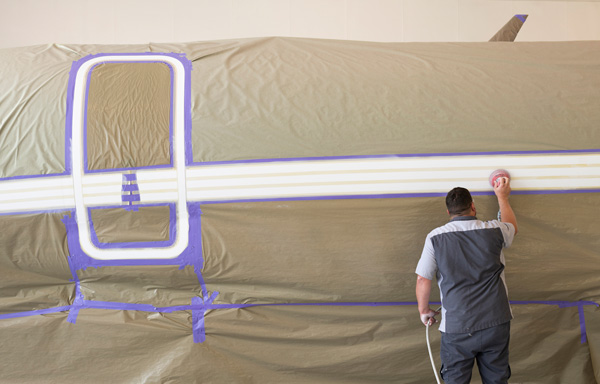Paint By N-Number
November 2019
Aircraft aren’t just painted to make them pretty; they’re painted to protect the structure from failure. Every time you fly your aircraft, it’s exposed to environmental elements that will damage the paint over time.

Sun exposure fades paint, wind and sand scratch it, and heat and cold alternately cause the paint to expand and contract – which causes cracking and pitting. Mix in humidity, sea water, air pollution, and ice, and over time, corrosion may start to form, even if only at a microscopic level.
On a metal surface, corrosion needs only oxygen and moisture to get started. Although both elements are necessary for life on earth, they can be detrimental to your aircraft.
Your aircraft also is continually subjected to the normal stresses of flight, including severe temperature and pressure changes. Every component of an aircraft is affected, and eventually, when coupled with corrosion, the structural integrity of the aircraft can be compromised.
What can you do to protect your aircraft?
Inspect your aircraft regularly. As the aircraft ages, the joints become worn, skins stretch, and structural components begin to weaken. Evidence of these changes is not always immediately visible, so a solid maintenance program is a must.
- Add a new, high-quality exterior coat of paint as a necessary maintenance event. An exterior paint refurbishment not only increases the value and performance of your aircraft, it also may help prevent future corrosion. Have your aircraft stripped, inspected, and repainted by a reputable aircraft paint facility every five to seven years. As you’re selecting colors and a new stripe scheme, be sure that all door jambs, airstairs, gear, wheels/brakes, fasteners, windows, lenses, seams, and seals are inspected, to determine what might need repair or replacement. This will ensure that you’re comfortable with the steps being taken to evaluate the current condition of your aircraft and its long term care. Rather than scheduling a separate time to take your aircraft out of its flight rotation, consider adding exterior paint refurbishment when your aircraft is already down for major maintenance.
- Keep your aircraft in a hangar when it’s not flying to offer some protection and to extend the life of your paint.
- As you take delivery of your newly painted aircraft, you or your maintenance supervisor should take time to review the ongoing maintenance items with the paint facility to understand how to keep the exterior paint looking shiny and clean.
- At regular inspection intervals, evaluate the paint condition and have the paint touched up when you begin to notice environmental and moisture intrusion areas around rivets, fasteners, seams, or other wear or flex areas of the aircraft. Sealing these cracks and pits will help provide a longer lasting finish and protect the aircraft from the potential progression of the corrosion.
- Keep up-to-date. Paint technology has improved and will continue to evolve as new products and processes are developed. Pre-coat washes and primers provide a majority of the chemistry related to corrosion protection, and proper care of topcoats through regular cleaning and care will also affect the appearance of the exterior paint on your aircraft.
Corrosion can form in different places on or inside the aircraft. Regardless of the type or location of the corrosion, it’s important to have a prevention plan in place. While there is no guarantee that painting your aircraft on a regular basis will prevent all corrosion repairs in the future, if you do not do so, you will be faced with corrosion at some point in the life of your aircraft.
Many owners paint an aircraft thinking how beautiful the stripes and shiny base colors will look. But paying attention to the condition of the paint can pay far larger long-term dividends on the value and safety of the aircraft.
